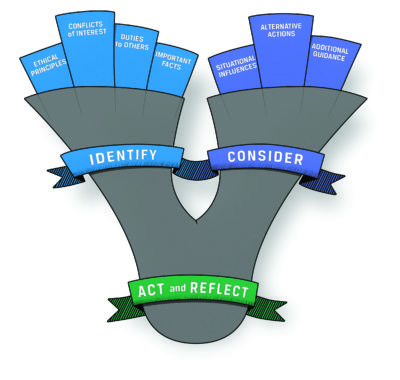Ethics in Practice: Exchange Listing. Case and Analysis–Week of 12 November
How did you do evaluating this week’s (12 November) case? Check out the analysis below.
Case
Ackerman is a securities contractor working to assist Superior Western Energy (SWE) list its shares on the Australian Security Exchange (ASX). SWE filed a prospectus for an offer of up to five million shares at $2 each to raise $10 million. The ASX listing rule applicable at the time required that entities seeking admission to the ASX must meet a “minimum spread requirement” of at least 300 shareholders with a minimum value holding to qualify for listing on the exchange. In their listing application, representatives of SWE informed ASX that the minimum spread requirement of 300 shareholders had been met. These disclosures included as shareholders 31 people or companies arranged by Ackerman. But none of the supposed shareholders were genuine buyers of SWE securities; Ackerman had provided false names and addresses for the investors. The SWE share offer raised more than $3.5 million, with more than 1.75 million shares being issued. SWE was admitted to the official list of the ASX, and its shares were quoted on that exchange. Over time, the price of SWE shares steadily increased, the company attracted hundreds of investors and shareholders, and early investors achieved an excellent investment return. Ackerman’s actions were
- unacceptable.
- acceptable because SWE proved to be a strong company with excellent performance.
- acceptable because no investors were harmed by a technical violation of ASX rules.
- acceptable if SWE would have met the minimum spread requirement without the 31 fictitious investors claimed by Ackerman.
Analysis
This case relates to CFA Institute Standard of Professional Conduct II(B): Market Manipulation, which prohibits CFA Institute members from engaging in practices that artificially inflate trading volume to mislead market participants. In this case, Ackerman engaged in information-based manipulation by falsely inflating the number of initial investors in the SWE securities. According to the Australian Securities and Investments Commission, the purpose of the minimum requirements for securities to be listed on the ASX is to demonstrate that there is sufficient investor interest in the company to justify its listing. This operates to ensure some level of liquidity at the time the company is initially listed and keeps poorer quality applicants that are not able to attract sufficient investor interest to meet the minimum spread requirement from being admitted to the ASX official list.
Falsifying the number of initial investors, therefore, goes beyond a technical violation of ASX rules and has substantive consequences. The fact that SWE ultimately proved to be a bona fide and solid investment does not mitigate Ackerman’s conduct. Even if SWE met the minimum spread requirement without the 31 invented investors, Ackerman’s misrepresentations still falsely pumped up the initial interest in SWE securities to circumvent regulatory requirements and drive interest in the investment. Choice A is the best answer.
This case is based on a 22 October 2018 Enforceable Undertaking by the Australian Securities and Investments Commission.
Let us know what you think of Ethics in Practice by taking this short survey.
Have an idea for a case for us to feature? Send it to us at [email protected].
More About the Ethics in Practice Series
Just as you need to practice to become proficient at playing a musical instrument, public speaking, or playing a sport, practicing assessing and analyzing situations and making ethical decisions develops your ethical decision-making skills. The Ethics in Practice series gives you an opportunity to “exercise” your ethical decision-making skills. Each week, we post a short vignette, drawn from real-world circumstances, regulatory cases, and CFA Institute Professional Conduct investigations, along with possible responses/actions. We then encourage you to assess the case using the CFA Institute Ethical Decision-Making Framework and through the lens of the CFA Institute Code of Ethics and Standards of Professional Conduct. Then join the conversation and let us know which of the choices you believe is the right one and explain why. Later in the week, we will post an analysis of the case and you can see how your response compares.
Image Credit: ©CFA Institute


I am pursuing CFA LEVEL 1 from
Edupristine Mumbai institute